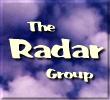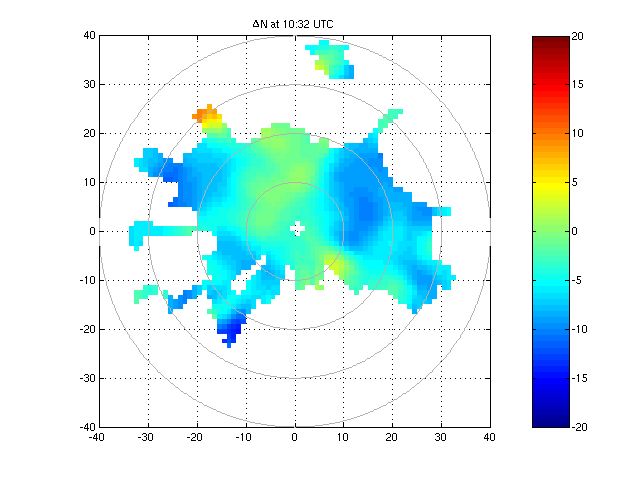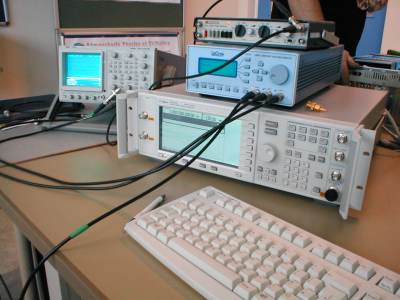











Last update
19 Nov 2004

This page is maintained by
Mark Fielding
All content Copyright © The University of Reading unless otherwise stated.
UFAM 1275 MHz Clear-air Radar: ACROBAT
an Advanced Clear-air Radar for Observing the Boundary layer And Troposphere

Photo: Owain Davies (CCLRC) |
BackgroundRadar backscatter at in the 500-1500 MHz range ("L-band" in radio terminology) occurs due to a combination of Rayleigh scattering from hydrometeors and Bragg scatter from turbulent refractive index inhomogeneities. These returns from invisible refractive index fluctuations make the 'clear-air' radar technique possible, whereby a sensitive radar can detect echoes from the air itself, and thereby measure its motion. A 1275 MHz Doppler radar has recently been installed at Chilbolton, designed to add clear-air capability to the existing suite of instruments at the site.Because clear-air Doppler radars are able to directly sense the motion of the air, they are most commonly employed as wind profilers, both operationally (by weather services and airports) and for research. Wind profilers point vertically, and measure the wind components by electronically steering the beam a few degrees off vertical. However, since the Chilbolton radar is mounted on the main 25-m dish, it has the unique capability of being physically scanned in almost any direction, allowing the user to obtain a 'snapshot' of the atmospheric structure in a vertical or azimuthal plane. The large dish size also leads to a particularly narrow beam-width for this class of radar (approx. 0.7°). |
Convection studies
ACROBAT has proved to be an excellent tool for studying convective structures in the boundary layer. Since convection, by its very nature, is associated with strong temperature and humidity gradients, it leads to strong clear-air radar returns in the boundary layer. Convective structures lead to a characteristic pattern of arches and plumes in RHI scans of radar reflectivity. In PPI scans, convective elements are often visible as ring-shaped structures, indicating the strong refractive index gradients at the edges of individual convective cells.
ACROBAT played a key role in the Convective Storm Initiation Project (CSIP) pilot campaign in Summer 2004. The radar will again provide real-time images of the evolution of convection during the main CSIP campaign in 2005.

Above: RHI scan from the ACROBAT radar on 10 July 2004 (during CSIP)
showing radar reflectivity
in the boundary layer.
The complex structure below 2km is
due to developing convective activity.
Refractivity measurements
The ACROBAT radar transmitter and receiver are phase-locked to a stable frequency reference. This allows the radar to make accurate measurements of the phase of radar echo returns. Fabry et al. (1997) showed how such phase measurements can be used to measure fields of surface refractive index changes. By isolating the returns from stable ground clutter targets and tracking the phase of their radar returns with time, changes in refractive index in the paths between these targets can be monitored. This allows fields of refractivity variations to be obtained with an accuracy of a few parts per million.The radio refractive index of the atmosphere is highly dependent on humidity, and these refractivity measurements will be extremely useful in tracking humidity anomalies associated with the onset of convection and precipitation.

Above: Field of horizontal refractive index anomalies measured on 10 July
2004. The green band in the middle of the field (higher refractivity than
the surroundings) is associated with a convective system passing over
the radar site.
The distance scale indicates kilometres from the radar.
 System status (18/11/04): The ACROBAT system is fully operational.
System status (18/11/04): The ACROBAT system is fully operational.
 Click here for a
technical overview of the radar system.
Click here for a
technical overview of the radar system.
 We welcome suggestions from researchers wishing
to use this facility. For more information, please contact the Instrument
Scientist, Ed Pavelin (e.pavelin@reading.ac.uk, tel. 0118 378 7381).
We welcome suggestions from researchers wishing
to use this facility. For more information, please contact the Instrument
Scientist, Ed Pavelin (e.pavelin@reading.ac.uk, tel. 0118 378 7381).

|
Radar specifications Operating frequency: 1275 MHz Operating frequency: 1275 MHz Peak power: 1 kW at feed Peak power: 1 kW at feed Antenna diameter: 25 m Antenna diameter: 25 m Beam width: 0.75° Beam width: 0.75° Pulse repetition frequency: 3125 Hz (typical) Pulse repetition frequency: 3125 Hz (typical) Minimum range: 1.8 km (typical) Minimum range: 1.8 km (typical) Maximum range: 48 km (typical) Maximum range: 48 km (typical) Pulse duration: 0.8 µs x 8 bits (typical) Pulse duration: 0.8 µs x 8 bits (typical) Range resolution: 60 m Range resolution: 60 m Pulse coding: Complementary code sequence
(8 bits x 8 codes) Pulse coding: Complementary code sequence
(8 bits x 8 codes) Max. unambiguous Doppler velocity: 23 m/s
(typical) Max. unambiguous Doppler velocity: 23 m/s
(typical) |
